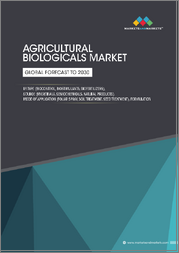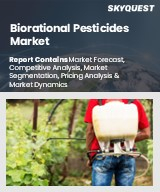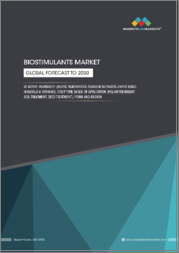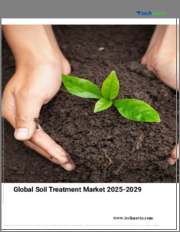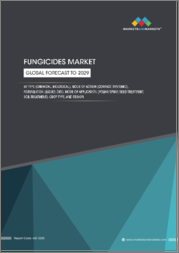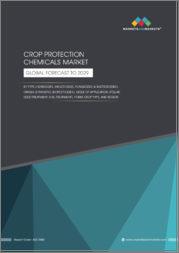
|
시장보고서
상품코드
1832100
토양 처리 시장 규모, 점유율, 동향, 예측 : 유형, 기술, 최종 사용자, 지역별(2025-2033년)Soil Treatment Market Size, Share, Trends, and Forecast by Type, Technology, End User, and Region, 2025-2033 |
||||||
세계의 토양 처리 시장 규모는 2024년에 453억 달러에 달했습니다. 향후 IMARC 그룹은 2033년까지 694억 달러에 이르며, 2025년부터 2033년까지 4.9%의 연평균 복합 성장률(CAGR)을 나타낼 것으로 예측했습니다. 현재 북미가 시장을 독점하고 있으며 2024년에는 38.5% 이상의 큰 시장 점유율을 차지했습니다. 지속가능하고 유기적인 토양 처리 기법 채택 증가, 토양 처리 과정에서 실시간 모니터링 및 데이터 구동 의사결정을 위한 디지털 기술의 통합은 시장 성장을 가속하는 주요 요인의 일부입니다.
세계의 토양 처리 시장은 토양 열화와 싸우면서 농업생산성을 향상시킬 필요성이 높아지고 있기 때문에 현재 활황을 보이고 있습니다. 세계적으로 식량 수요가 높고 경작 가능한 토지가 감소하고 있다는 것은 비옥도와 구조를 개선하기 위한 토양 처리의 사용에 박차를 가하고 있습니다. 게다가 유기농 식품에 대한 요구는 유기농업과 정밀농업기술에 대한 수요를 증대시켜 환경친화적인 토양 처리제품의 길을 열었습니다. IMARC 그룹에 따르면 전 세계 유기농 식품 시장 규모는 2032년까지 5,289억 달러로 성장하며, 2024년 중 CAGR은 10.97%를 나타낼 것으로 예측되고 있습니다. 고급 치료법의 채택은 환경 문제와 규제 요구 사항에도 대응합니다. 또한 토양의 건전성을 증진시키는 정부의 이니셔티브와 함께 조경 및 원예에서 토양 처리의 사용이 증가하고 있는 것도 업계 전체의 성장을 더욱 뒷받침하고 있습니다.
미국은 토양 처리의 주요 지역 시장으로 부상하고 있습니다. 미국의 토양 처리 시장은 주요 시장 파괴자로 두드러집니다. 집약적 농업 경영의 영향을 강하게 받은 지역에서 지속 가능한 농업과 비옥한 토지의 회복에 대한 관심이 높아지고 있기 때문입니다. 작물을 수확하기 위해서는 토양의 건강이 중요하다는 인식이 높아지고, 바이오베이스나 유기 개량재 등, 보다 고도의 토양 처리법에 대한 수요가 높아지고 있습니다. 또한 유기농 및 고품질 농산물에 대한 요구가 증가하고 비료에 의한 화학물질의 사용량 감소도 미국에서 토양 처리의 채용을 증가시키고 있습니다. IMARC Group이 발표한 보고서에 따르면 미국의 유기농 식품 시장 규모는 2032년까지 1,582억 달러에 달하며, 2024-2032년의 CAGR은 7.47%를 나타낼 것으로 예측됩니다. 이 외에도 친환경 농업 실천을 장려하는 정부 제도와 금융 지원이 시장 성장을 가속하고 있습니다.
토양 처리 시장 동향
효과적인 해충 관리의 요구 증가
선충, 진균, 세균 등의 토양 전염성 해충의 만연이 증가하고 있어, 작물의 수량이나 토양의 건강에 큰 영향을 미치고 있기 때문에 토양 마이크로 바이옴의 밸런스를 강화하거나 해충의 개체수를 억제하거나 하는 토양 처리 기술의 요구가 높아지고 있습니다. 예를 들어, 한 연구에 따르면, 흰개미의 만연은 대두에서는 뿌리 시스템을 약 25%, 옥수수에서는 64% 감소시킵니다. 브라질과 같은 남미 국가에서는 Phyllophaga capillata와 Aegopsis bolboceridus가 모든 평가 변수에 손상을 입히고 대두 생산성을 58.62%, 옥수수 생산성을 59.76% 감소시키는 것으로 관찰되었습니다. 마찬가지로 Meloidogyne incognita와 Pratylenchus brachyurus와 같은 선충류는 과일 및 채소에 큰 손실을 초래합니다. 예를 들어 당근은 이러한 해충으로 인해 수확량의 20.0%를 잃을 수 있습니다. 이 해충은 토양에 서식하기 때문에 살선충제를 사용하여 해충을 제거하고 작물을 보호해야합니다. 그 결과 토양 처리 솔루션에 대한 요구가 높아지고 있어 향후 수년간 토양 처리 시장 점유율을 크게 끌어올릴 것으로 예측됩니다.
고품질 식품에 대한 수요 증가
유기농 고품질 식품에 대한 수요 증가는 세계의 토양 처리 시장에 밝은 전망을 제공합니다. 고품질 식품의 생산은 작물에 필수 영양소를 공급하는 비옥한 토양에 크게 의존합니다. 이것은 작물의 수확량, 영양분 및 식품 전체의 품질에 영향을 미칩니다. 세계 인구 증가, 가처분 소득 증가, 생활 수준의 향상은 식품과 농산물에 대한 수요 증가를 가져옵니다. 산업계 데이터에 따르면 식량곡물의 총 수요는 2030년까지 3억 1,100만 톤 수준으로 성장하며, 그 내역은 쌀이 1억 2,200만 톤, 밀이 1억 1,500만 톤, 곡물 곡물이 4,700만 톤, 콩류가 2,700만 톤입니다. 이 외에도 각국 정부 당국은 유기농업을 추진하는 이니셔티브를 취하고 있으며, 이는 토양 처리 솔루션 시장을 더욱 자극하고 있습니다. 예를 들어, 인도 정부(GoI)에 의한 유기농업에 관한 국가 프로그램과 Paramparagat Krishi Vikas Yojana와 같은 농가에 대한 자금 지원을 통해 국내 바이오 농업을 촉진하기 위한 유리한 이니셔티브의 도입은 업계 전체의 확대를 촉진하고 있습니다.
기술 진보
효율적인 오염물질 제거를 위한 바이오레미디에이션, 열탈착, 동전학과 같은 첨단 토양 처리기술의 채용은 시장에 유리한 성장 기회를 창출하고 있습니다. 게다가 다양한 주요 시장 기업들이 토양 처리 기술에 대한 투자를 늘리고 있어 첨단 기술과 방법을 개발하고 있습니다. 예를 들어, 2024년 3월, CSIR-Indian Institute of Chemical Technology(IICT)는 말린 잎을 "토양 개량제"로 전환 시연하는 데 성공했습니다. Accelerated Anaerobic Composting(ACC)로 알려진 이 방법은 바이오가스가 아닌 바이오비료만을 생산합니다. 마찬가지로 2023년 10월, 라이스 대학의 과학자와 미국 육군 기술 R&D 센터(ERDC)의 공동 연구자들은 토양에서 중금속과 유기 오염물질을 제거하는 신속한 고온 공정을 개발했습니다. 게다가 현재 진행 중인 토양 처리기술의 연구개발(R&D)은 다양한 토양오염물질에 대응하여 세계의 엄격한 규제 요건을 충족하는 시장의 가능성을 확대하고 있습니다. 최근 토양유기탄소(SOC)의 측정과 예측에 특화된 디지털 측정, 보고, 검증의 신흥기업인 Downforce Technologies사는 Equator VC가 주도하는 자금조달 라운드로 420만 달러를 조달했습니다.
목차
제1장 서문
제2장 조사 범위와 조사 방법
- 조사의 목적
- 이해관계자
- 데이터 소스
- 1차 정보
- 2차 정보
- 시장 추정
- 상향식 접근
- 하향식 접근
- 조사 방법
제3장 주요 요약
제4장 서론
제5장 세계의 토양 처리 시장
- 시장 개요
- 시장 실적
- COVID-19의 영향
- 시장 예측
제6장 시장 분석 : 유형별
- 유기질 개량제
- pH 조절제
- 토양 보호
제7장 시장 분석 : 기술별
- 생물학적 처리
- 열처리
- 물리화학적 처리
제8장 시장 분석 : 최종 사용자별
- 농업
- 건설
- 기타
제9장 시장 분석 : 지역별
- 북미
- 미국
- 캐나다
- 아시아태평양
- 중국
- 일본
- 인도
- 한국
- 호주
- 인도네시아
- 기타
- 유럽
- 독일
- 프랑스
- 영국
- 이탈리아
- 스페인
- 러시아
- 기타
- 라틴아메리카
- 브라질
- 멕시코
- 기타
- 중동 및 아프리카
제10장 SWOT 분석
제11장 밸류체인 분석
제12장 Porter's Five Forces 분석
제13장 가격 분석
제14장 경쟁 구도
- 시장 구조
- 주요 기업
- 주요 기업 프로파일
- AMVAC Chemical Corporation(American Vanguard Corporation)
- Arkema SA
- BASF SE
- Bayer AG
- Compagnie de Saint-Gobain SA
- Corteva Inc.
- Novozymes A/S
- Solvay SA
- Swaroop Agrochemical Industries
- Syngenta Group(China National Chemical Corporation)
- Tata Chemicals Ltd.
- UPL Limited
The global soil treatment market size was valued at USD 45.3 Billion in 2024. Looking forward, IMARC Group estimates the market to reach USD 69.4 Billion by 2033, exhibiting a CAGR of 4.9% during 2025-2033. North America currently dominates the market, holding a significant market share of over 38.5% in 2024. Increasing adoption of sustainable and organic soil treatment methods and the integration of digital technologies for real-time monitoring and data-driven decision-making in soil treatment processes are some of the key factors driving the market growth.
The global market for soil treatment is currently thriving due to the growing requirement to enhance agricultural productivity while combating soil degradation. High demand for food across the globe and diminishing land available for cultivation is fueling the use of soil treatments to improve fertility and structure. In addition, the need for organic food products increased the demand for organic farming and precision agriculture techniques; hence, it created avenues for eco-friendly soil treatment products. According to IMARC Group, the size of the global organic food market has been forecasted to grow up to US$ 528.9 Billion by 2032, with a projected CAGR of 10.97% during 2024-2032. The adoption of advanced treatment methods also addresses environmental concerns and regulatory requirements. Moreover, the increasing use of soil treatment in landscaping and horticulture, along with government initiatives that promote soil health, is further encouraging overall industry growth.
The United States has emerged as a key regional market for soil treatment. The United States soil treatment market stands out as a key market disruptor, as increasing interest is being shown towards sustainable agriculture and fertile land restoration in areas heavily influenced by intensive farming operations. Increasing awareness about the significance of soil health to yield crops has led to demand for more advanced treatment methods of soils, including bio-based and organic amendments. In addition, rising needs for organic, high-quality produce, and decreasing chemical use through fertilizers also increases soil treatment adoption in the United States. As per a report published by the IMARC Group, the United States organic food market size is expected to reach US$ 158.2 Billion by 2032, exhibiting a CAGR of 7.47% during 2024-2032. Besides this, government schemes and financial aids encouraging green farming practices are enhancing market growth.
Soil Treatment Market Trends
Escalating Need for Effective Pest Management
The increasing prevalence of soilborne pests, such as nematodes, fungi, and bacteria, is significantly impacting crop yields and soil health, which is primarily driving the need for soil treatment techniques that enhance soil microbiome balance or suppress pest populations. For instance, according to a study, the white grub infestation reduces the root system by approximately 25% in soybeans and 64% in maize. It was observed that Phyllophaga capillata and Aegopsis bolboceridus damaged all evaluated variables, reducing overall soybean productivity by 58.62% and maize productivity by 59.76% in South American countries such as Brazil. Similarly, Nematodes such as Meloidogyne incognita and Pratylenchus brachyurus cause big losses in fruits and vegetables. For instance, carrots can lose up to 20.0% of their crop due to such pests. As these pests live in the soil, the need to use nematicides to mitigate them and protect the crops is essential. Consequently, there is a rising need for soil treatment solutions, which is anticipated to significantly propel the soil treatment market share in the coming years.
Growing Demand for Quality Food
The increasing demand for organic and quality food is further creating a positive outlook for the global soil treatment market. Quality food production relies heavily on fertile soil that provides essential nutrients to crops. This, in turn, influences crop yield, nutrition content, and overall food quality. The growing global population, inflating disposable incomes, and elevating standards of living are resulting in an increased demand for food and agricultural products. According to industrial data, the total food grain demand will grow to the level of 311 Million Tons, which includes 122, 115, 47, and 27 Million tons of rice, wheat, coarse cereals, and pulses, respectively, by the year 2030. Besides this, the government authorities of various nations are taking initiatives to promote organic farming practices, which is further stimulating the market for soil treatment solutions. For instance, the introduction of favorable initiatives, such as the National Program on Organic Farming and the Paramparagat Krishi Vikas Yojana by the Government of India (GoI) to promote bio-agriculture in the country through financial assistance to farmers, is facilitating overall industry expansion.
Technological Advancements
Adoption of advanced soil treatment technologies such as bioremediation, thermal desorption, and electrokinetic for efficient contaminant removal are creating lucrative growth opportunities to the market. Moreover, various key market players are increasingly investing in soil treatment technologies to develop more advanced techniques and methods. For instance, in March 2024, the CSIR-Indian Institute of Chemical Technology (IICT) successfully demonstrated the conversion of dry leaves into a 'soil conditioner'. This method, known as Accelerated Anaerobic Composting (ACC), ensures that only bio-manure is generated, not biogas. Similarly, in October 2023, Rice University scientists and collaborators at the United States Army Engineer Research and Development Center (ERDC) developed a rapid high-temperature process that removes heavy metals and organic contaminants from the soil. Moreover, ongoing research and development (R&D) in soil treatment technologies are expanding the market's potential to address diverse soil contaminants and meet stringent regulatory requirements worldwide. Recently, Downforce Technologies, a digital measurement, reporting and verification startup focused on soil organic carbon (SOC) measurement and prediction, has raised USD 4.2 Million in a funding round led by Equator VC.
Soil Treatment Industry Segmentation:
Analysis by Type:
- Organic Amendments
- pH Adjusters
- Soil Protection
pH adjusters lead the market globally. pH adjusters in soil treatment are vital for modifying soil acidity or alkalinity to optimize plant growth and remediate contaminated soils. They include substances such as lime (calcium hydroxide) to raise pH for neutralizing acidic soils, and sulfur to lower pH for alkaline soil remediation. These adjusters help regulate nutrient availability, enhance microbial activity, and improve soil structure, which is essential for agricultural productivity and environmental restoration. Additionally, pH adjusters play a vital role in ensuring effective uptake of nutrients by plants, promoting sustainable soil management practices, and mitigating adverse effects of soil contaminants through tailored pH correction strategies.
Analysis by Technology:
- Biological Treatment
- Thermal Treatment
- Physiochemical Treatment
Physiochemical treatment leads the market with around 58.8% of market share in 2024. Physiochemical treatment in soil treatment involves processes that physically and chemically alter contaminants in soil to reduce their toxicity or mobility. This method combines physical techniques such as soil washing, screening, or thermal desorption with chemical methods such as oxidation, precipitation, or stabilization. Soil contaminants such as heavy metals, petroleum hydrocarbons, and persistent organic pollutants are targeted through these processes, aiming to degrade or isolate pollutants from soil matrices. Physiochemical treatment offers versatility in addressing diverse contaminants and is often tailored to site-specific conditions to achieve effective remediation and restore soil quality for safe land use purposes.
Analysis by End User:
- Agricultural
- Construction
- Others
Agricultural sector leads the market worldwide. Managing pests effectively is essential for ensuring food security and maintaining a stable food supply. Additionally, the escalating demand for quality food is also propelling the growth of this segment. For instance, the total global food demand is expected to increase by 35% to 56% between 2010 and 2050, while the population at risk of hunger is expected to change by -91% to +8% over the same period. Besides this, increasing infestation of soilborne pests, diseases, and weeds is also bolstering the need for effective soil treatment solutions. By optimizing soil health through treatments such as fertilization, organic amendments, and pH adjustments, agricultural productivity can be maximized while minimizing environmental impact. Ultimately, soil treatment ensures long-term soil sustainability, supporting food security and maintaining ecosystem health in agricultural landscapes.
Regional Analysis
- North America
- United States
- Canada
- Europe
- Germany
- France
- United Kingdom
- Italy
- Spain
- Russia
- Others
- Asia Pacific
- China
- Japan
- India
- South Korea
- Australia
- Indonesia
- Others
- Latin America
- Brazil
- Mexico
- Others
- Middle East and Africa
In 2024, North America accounted for the largest market share of over 38.5%. Agriculture in North America is highly diverse, with a wide range of crops cultivated across different countries. The region's diverse climate and fertile land enable the cultivation of crops such as wheat, corn, soybean, canola, and various fruits and vegetables. Furthermore, as per the soil treatment market forecast by IMARC, the significantly rising population across the region is bolstering the demand for high-quality food. According to the Canadian Agriculture Human Resource Council, Canada's farm labour deficit is anticipated to double by 2029 and lead to a 123,000-worker shortage. This will increase the need for soil treatment solutions to enhance crop yield. Additionally, various key market players are collaborating to introduce new and improved soil treatment solutions, which are further catalysing market growth. For instance, in May 2021, Corteva Agriscience and BASF Canada Agricultural Solutions (BASF) partnered toward a joint approach to weed control by recommending the combined use of Liberty 200 SN and Enlist herbicides on Enlist E3TM soybean acres. This partnership is anticipated to increase the use of herbicides, thereby expanding the market growth.
Key Regional Takeaways:
United States Soil Treatment Market Analysis
In 2024, United States accounts for over 72.5% of the soil treatment market in North America. The large-scale farming, combined with tougher environmental regulations, is driving the market for soil treatments in the United States. As per USDA, over 45% of arable land was classified as degraded in 2023. Consequently, government initiatives such as Conservation Reserve Program (CRP) and Environmental Quality Incentives Program (EQIP) are investing heavily in soil health and conservation. Adoption of bio-based soil conditioners registered 15% growth during 2023, when farmers increasingly sought products such as compost, biochar, and microbial amendments to enhance the fertility and water retention capacity. Moreover, numerous companies, including UPL and BASF, are using advanced technologies to deliver controlled-release soil conditioners and nutrient enhancers. Rising awareness among U.S. farmers regarding climate change mitigation has also boosted the demand for soil carbon sequestration techniques, contributing to the country's goal of achieving net-zero emissions by 2050.
Europe Soil Treatment Market Analysis
Europe's market for soil treatment is gaining momentum, backed by tough frameworks of regulation and sustainable agriculture. Approximately 35% of agricultural land in the European Union is suffering from soil degradation. This highlights a pressing need for soil treatment solutions in Europe. The Common Agricultural Policy (CAP) provided USD 58.8 Billion in 2023 for sustainable farming and environmental conservation. Germany, France, and the Netherlands are keen in adopting bio-based soil amendments and pH balancers, with a 16% increase recorded in demand for eco-friendly products in 2023. Moreover, the European Green Deal's "Farm to Fork" strategy outlines a reduction of at least 50% of chemical pesticide use and 20% of fertilizer use by 2030. This is encouraging innovation in microbial-based soil conditioners. Additionally, advanced products by companies such as Bayer and Syngenta address specific challenges related to soil health while adhering to regional sustainability goals, further propelling industry expansion.
Asia Pacific Soil Treatment Market Analysis
The market for Asia Pacific soil treatment is rapidly growing, driven by increasing food demand in the region and decreasing soil fertility. According to the Food and Agriculture Organization (FAO), 62% of farmland in Asia Pacific suffers moderate to severe soil degradation, with water erosion and desertification being the major concerns in the region. Consequently, numerous countries are increasingly investing in improving soil health in this region with various governmental programs. Some of these include China's "Black Soil Protection Program" and the Soil Health Card Scheme in India, where over 220 Million farmers have benefited since 2023. Furthermore, organic soil amendments and biofertilizers experienced a 20% uptake in 2023 due to increasing awareness about sustainable agricultural practices. Japan and South Korea are also making heavy investments in precision agriculture technologies to optimize soil health and reduce chemical dependency. Local companies such as Coromandel International are working in partnership with global players to introduce innovative solutions tailored to diverse regional needs and to create a more resilient agricultural sector.
Latin America Soil Treatment Market Analysis
Latin America's agricultural sector is significantly influencing its soil treatment market. The region faces challenges in terms of soil erosion and nutrient depletion, which have decreased agricultural productivity. According to an industrial report, approximately 267 Million people in Latin America and the Caribbean suffer from food insecurity. This means that 40% of the population lacks physical or economic access to sufficient safe and nutritious food to meet their daily needs and lead a healthy life. Consequently, investment in conservation practices is increasing, where countries such as Brazil are adopting soil amendment methods for better crop yields. Companies such as Yara and Mosaic are also expanding their businesses in this region with solutions best suited to the soil conditions in Latin America.
Middle East and Africa Soil Treatment Market Analysis
The Middle East and Africa region deals with dry conditions and land degradation. As per FAO, around 28% of the land area in the region is experiencing some degree of land degradation. As a result, Saudi Arabia is committing investments through initiatives such as Vision 2030 toward agricultural sustainability projects, which are increasing the demand for soil conditioners and pH balancers. Firms such as FMC Corporation are innovating water-saving soil treatment products as suited to the requirements of the region.
Competitive Landscape:
Key players in the global soil treatment market are actively driving growth through strategic initiatives aimed at innovation and sustainability. Numerous companies are investing in research and development (R&D) to introduce bio-based and eco-friendly soil treatment solutions, such as organic soil conditioners and microbial amendments, aligning with the growing demand for sustainable agriculture. Collaborations with agricultural research institutions and partnerships with farmers are also fostering the adoption of advanced soil health management practices. Moreover, leading manufacturers are expanding their global presence through mergers, acquisitions, and regional partnerships to tap into emerging markets. Digital transformation efforts, including precision agriculture technologies and soil health monitoring systems, are being integrated into product offerings to enhance efficiency and performance. Additionally, companies are focusing on educating end-users through awareness campaigns and training programs on the benefits of soil treatment. These proactive measures by key players are positively influencing the market, supporting sustainable farming and boosting agricultural productivity worldwide.
The report provides a comprehensive analysis of the competitive landscape in the soil treatment market with detailed profiles of all major companies, including:
- AMVAC Chemical Corporation (American Vanguard Corporation)
- Arkema S.A.
- BASF SE
- Bayer AG
- Compagnie de Saint-Gobain S.A.
- Corteva Inc.
- Novozymes A/S
- Solvay S.A.
- Swaroop Agrochemical Industries
- Syngenta Group (China National Chemical Corporation)
- Tata Chemicals Ltd.
- UPL Limited
Key Questions Answered in This Report
- 1.What is soil treatment?
- 2.How big is the global soil treatment market?
- 3.What is the expected growth rate of the global soil treatment market during 2025-2033?
- 4.What are the key factors driving the global soil treatment market?
- 5.What is the leading segment of the global soil treatment market based on the type?
- 6.What is the leading segment of the global soil treatment market based on technology?
- 7.What is the leading segment of the global soil treatment market based on the end user?
- 8.What are the key regions in the global soil treatment market?
- 9.Who are the key players/companies in the global soil treatment market?
Table of Contents
1 Preface
2 Scope and Methodology
- 2.1 Objectives of the Study
- 2.2 Stakeholders
- 2.3 Data Sources
- 2.3.1 Primary Sources
- 2.3.2 Secondary Sources
- 2.4 Market Estimation
- 2.4.1 Bottom-Up Approach
- 2.4.2 Top-Down Approach
- 2.5 Forecasting Methodology
3 Executive Summary
4 Introduction
- 4.1 Overview
- 4.2 Key Industry Trends
5 Global Soil Treatment Market
- 5.1 Market Overview
- 5.2 Market Performance
- 5.3 Impact of COVID-19
- 5.4 Market Forecast
6 Market Breakup by Type
- 6.1 Organic Amendments
- 6.1.1 Market Trends
- 6.1.2 Market Forecast
- 6.2 pH Adjusters
- 6.2.1 Market Trends
- 6.2.2 Market Forecast
- 6.3 Soil Protection
- 6.3.1 Market Trends
- 6.3.2 Market Forecast
7 Market Breakup by Technology
- 7.1 Biological Treatment
- 7.1.1 Market Trends
- 7.1.2 Market Forecast
- 7.2 Thermal Treatment
- 7.2.1 Market Trends
- 7.2.2 Market Forecast
- 7.3 Physiochemical Treatment
- 7.3.1 Market Trends
- 7.3.2 Market Forecast
8 Market Breakup by End User
- 8.1 Agricultural
- 8.1.1 Market Trends
- 8.1.2 Market Forecast
- 8.2 Construction
- 8.2.1 Market Trends
- 8.2.2 Market Forecast
- 8.3 Others
- 8.3.1 Market Trends
- 8.3.2 Market Forecast
9 Market Breakup by Region
- 9.1 North America
- 9.1.1 United States
- 9.1.1.1 Market Trends
- 9.1.1.2 Market Forecast
- 9.1.2 Canada
- 9.1.2.1 Market Trends
- 9.1.2.2 Market Forecast
- 9.1.1 United States
- 9.2 Asia-Pacific
- 9.2.1 China
- 9.2.1.1 Market Trends
- 9.2.1.2 Market Forecast
- 9.2.2 Japan
- 9.2.2.1 Market Trends
- 9.2.2.2 Market Forecast
- 9.2.3 India
- 9.2.3.1 Market Trends
- 9.2.3.2 Market Forecast
- 9.2.4 South Korea
- 9.2.4.1 Market Trends
- 9.2.4.2 Market Forecast
- 9.2.5 Australia
- 9.2.5.1 Market Trends
- 9.2.5.2 Market Forecast
- 9.2.6 Indonesia
- 9.2.6.1 Market Trends
- 9.2.6.2 Market Forecast
- 9.2.7 Others
- 9.2.7.1 Market Trends
- 9.2.7.2 Market Forecast
- 9.2.1 China
- 9.3 Europe
- 9.3.1 Germany
- 9.3.1.1 Market Trends
- 9.3.1.2 Market Forecast
- 9.3.2 France
- 9.3.2.1 Market Trends
- 9.3.2.2 Market Forecast
- 9.3.3 United Kingdom
- 9.3.3.1 Market Trends
- 9.3.3.2 Market Forecast
- 9.3.4 Italy
- 9.3.4.1 Market Trends
- 9.3.4.2 Market Forecast
- 9.3.5 Spain
- 9.3.5.1 Market Trends
- 9.3.5.2 Market Forecast
- 9.3.6 Russia
- 9.3.6.1 Market Trends
- 9.3.6.2 Market Forecast
- 9.3.7 Others
- 9.3.7.1 Market Trends
- 9.3.7.2 Market Forecast
- 9.3.1 Germany
- 9.4 Latin America
- 9.4.1 Brazil
- 9.4.1.1 Market Trends
- 9.4.1.2 Market Forecast
- 9.4.2 Mexico
- 9.4.2.1 Market Trends
- 9.4.2.2 Market Forecast
- 9.4.3 Others
- 9.4.3.1 Market Trends
- 9.4.3.2 Market Forecast
- 9.4.1 Brazil
- 9.5 Middle East and Africa
- 9.5.1 Market Trends
- 9.5.2 Market Breakup by Country
- 9.5.3 Market Forecast
10 SWOT Analysis
- 10.1 Overview
- 10.2 Strengths
- 10.3 Weaknesses
- 10.4 Opportunities
- 10.5 Threats
11 Value Chain Analysis
12 Porters Five Forces Analysis
- 12.1 Overview
- 12.2 Bargaining Power of Buyers
- 12.3 Bargaining Power of Suppliers
- 12.4 Degree of Competition
- 12.5 Threat of New Entrants
- 12.6 Threat of Substitutes
13 Price Analysis
14 Competitive Landscape
- 14.1 Market Structure
- 14.2 Key Players
- 14.3 Profiles of Key Players
- 14.3.1 AMVAC Chemical Corporation (American Vanguard Corporation)
- 14.3.1.1 Company Overview
- 14.3.1.2 Product Portfolio
- 14.3.2 Arkema S.A.
- 14.3.2.1 Company Overview
- 14.3.2.2 Product Portfolio
- 14.3.2.3 Financials
- 14.3.2.4 SWOT Analysis
- 14.3.3 BASF SE
- 14.3.3.1 Company Overview
- 14.3.3.2 Product Portfolio
- 14.3.3.3 Financials
- 14.3.3.4 SWOT Analysis
- 14.3.4 Bayer AG
- 14.3.4.1 Company Overview
- 14.3.4.2 Product Portfolio
- 14.3.4.3 Financials
- 14.3.4.4 SWOT Analysis
- 14.3.5 Compagnie de Saint-Gobain S.A.
- 14.3.5.1 Company Overview
- 14.3.5.2 Product Portfolio
- 14.3.5.3 Financials
- 14.3.5.4 SWOT Analysis
- 14.3.6 Corteva Inc.
- 14.3.6.1 Company Overview
- 14.3.6.2 Product Portfolio
- 14.3.6.3 Financials
- 14.3.7 Novozymes A/S
- 14.3.7.1 Company Overview
- 14.3.7.2 Product Portfolio
- 14.3.7.3 Financials
- 14.3.7.4 SWOT Analysis
- 14.3.8 Solvay S.A.
- 14.3.8.1 Company Overview
- 14.3.8.2 Product Portfolio
- 14.3.8.3 Financials
- 14.3.8.4 SWOT Analysis
- 14.3.9 Swaroop Agrochemical Industries
- 14.3.9.1 Company Overview
- 14.3.9.2 Product Portfolio
- 14.3.10 Syngenta Group (China National Chemical Corporation)
- 14.3.10.1 Company Overview
- 14.3.10.2 Product Portfolio
- 14.3.10.3 SWOT Analysis
- 14.3.11 Tata Chemicals Ltd.
- 14.3.11.1 Company Overview
- 14.3.11.2 Product Portfolio
- 14.3.11.3 Financials
- 14.3.12 UPL Limited
- 14.3.12.1 Company Overview
- 14.3.12.2 Product Portfolio
- 14.3.12.3 Financials
- 14.3.1 AMVAC Chemical Corporation (American Vanguard Corporation)






